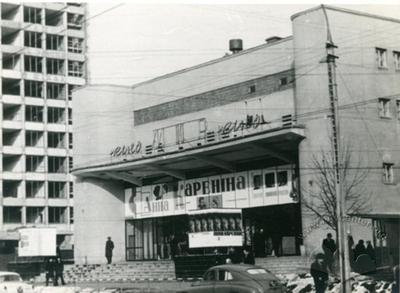Prosp. Chornovola, 4 – Oblast Statistical Department Building ID: 1978
Three State departments are housed in the building: the Department of Statistics, the State Committee on Land Resources, and the Machine Calculation Center. The structure went up between 1962-1967, designed by Myron Benzylovych and constructed in late-soviet Modernist style. As of 2012, the above-mentioned State departments share the premises with several private companies leasing space there
Story
The construction of the Regional Statistics Department was intended as a prototype for the further development of Lviv 700th Anniversary Street (Chornovola Avenue) into the new Lviv administrative and civic center. The project, designed by architects M. Mykula and M. Venzylovych, was not fully realized.The original design oriented the main transportation arterial to the north, toward Kyiv, with Lviv 700th Anniversary Street (currently Chornovola Avenue) intended to be representative of street design. It foresaw extending Lenin Avenue (currently, Svobody Avenue) an additional 1.5 kilometers from the rear of the Opera House. Along this road new administrative and civic structures were to form the re-envisioned center of Soviet Lviv.
Notable among structures in the plan that were realized are the Lviv Hotel, the Myr Cinema, and the Regional Statistics Department; blocks of older residential structures were razed prior to their construction.
The suspension of the project left the remaining residential buildings in the neighborhood untouched. Today the neighborhood has a fragmented appearance, with small-scale 19th-century urban residential construction characteristic of Lviv’s north end standing side by side with Soviet-era monumental modernist architecture.
Architecture
The lower floors of the office structure are occupied by a café and assembly hall. The detached structure is on Chornovola Prospect (formerly, Lviv 700th Anniversary Street), with a main entrance from a lane located between Chornovola Prospect and St. Theodore Square, and facing the Myr Cinema.Visually the structure resembles combination of two parallelepipeds – a two storey horizontal pedestal with a nine storey vertical tower placed on it. Characteristic of the spatial composition of classical Modernism, the two sections are seated at right angles to each other both on the horizontal and the vertical. The broader edge of the pedestal runs along Chornovola Avenue, while the broad edge of the tower is oriented perpendicularly to it.
The two storey houses a vestibule ensemble, a hall with elevators and staircases, assembly hall and the café Vatra. The tower is occupied by departmental offices which are located along the corridor connected by main and emergency stairwells.
The superstructure is comprised of both ground-bearing and suspended reinforced concrete slab in a 6x6 meter column arrangement, conventionalforsovietstructuresbuilt with pre-fabricated materials. The wider – northern and southern – façades of the tower hold curtain glass panel, aluminum frame curtain windows oriented on the horizontal.
Theoverall constructionischaracteristicofthe sovietModernistoffice (bureau) styleofthemid-20thcentury. Similar construction from the period dominated by Soviet architecture can be found throughout the cities of Ukraine.
People
Myron Venzylovych (August 26, 1919 – April 8, 1992) – Ukrainian architect. Born in the village of Solina (currently in Lesko County (powiat), Podkarpackie Province (voivodeship), Poland). From 1931 to 1938 he studied at Khyrivska Gymnasium, followed by the Cracow Arts Academy, and finally at the Construction Engineering Department at Lviv Polytechnic from 1946 to 1949. He worked at the Regional Rural Design Bureau (OblSilProject), then as a project engineer and Chief Architect at the Lviv affiliate of DniproMist. He resided in Lviv from 1953. Beginning in 1964, he taught the History of Design at Lviv State Institute of Applied and Decorative Art. In 1971 he became assistant professor, and then Department Head, and from 1984 Professor in the Interior Design Department. Between 1964-1971 he was the Head of the Lviv Branch of the Architectural Union. In 1971 he received the Taras Shevchenko National Award. He died in Lviv and is buried at the Lychakivske Cemetery.Sources
- Bendzylovchy family archives.
- In-house Archive, Lviv Oblast Statistical Bureau. Act #34/65, State Commission final project approval: Machine Calculation Center and UkrZemProekt Institute Project Center on Lviv 700th Anniversary Street, Lviv.
- In-house Archive, Lviv Oblast Statistical Bureau. Project proposal for the construction of a Machine Calculation Center and UkrZemProekt Institute Project Center on Lviv 700th Anniversary Street, Lviv. GosStroy, Ukrainian SSR.
- Bohdan Tscherkes, Nicholas Sawicki. Stalinist Visions for the Urban Transformations of Lviv, 1939–1955. Harvard Ukrainian Studies, 2000. #24, pp205-222.
- Biriulyov, Yuryi, ed. Architecture of Lviv: Times and Styles, 13th-21st centuries. Lviv: Center of Europe Publishing, 2008. pp624-720.















